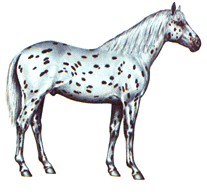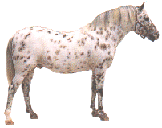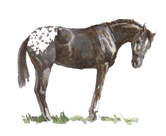|
|
The Appaloosa |
|
|
|
The Appaloosa |
|
 The popular American breed called Appaloosa is distinctive and popular as the American
version of the spotted horse. Spotted horse are depicted in cave drawings, and throughout Europe
and Asia, spotted horses were highly esteemed. The spotted gene found in horses is as old as
the equine race. Denmark has the
Knabstruper, and the French called them "tigres." They were called Blagdon, or Chubbarie (a Romany name), by the British. Although the spotted horses in Britain have not yet achieved breed status, there does exist a thriving British Appaloosa Society. Developed by the Nez Perce Indians in the eighteenth century, the American Appaloosa was based on the Spanish stock imported by the conquistadores, some of which carried the hereditary spotting genes. The lands of the Nez Perce included fertile, sheltered river valleys in northeastern Oregon, the chief of which was the Palouse River. Appaloosa is actually a corruption of "a Palouse horse." The Nez Perce were skillful as horse breeders and practiced a strict and selective breeding. This resulted in a distinctive, practical work horse which had the advantage of color.
The popular American breed called Appaloosa is distinctive and popular as the American
version of the spotted horse. Spotted horse are depicted in cave drawings, and throughout Europe
and Asia, spotted horses were highly esteemed. The spotted gene found in horses is as old as
the equine race. Denmark has the
Knabstruper, and the French called them "tigres." They were called Blagdon, or Chubbarie (a Romany name), by the British. Although the spotted horses in Britain have not yet achieved breed status, there does exist a thriving British Appaloosa Society. Developed by the Nez Perce Indians in the eighteenth century, the American Appaloosa was based on the Spanish stock imported by the conquistadores, some of which carried the hereditary spotting genes. The lands of the Nez Perce included fertile, sheltered river valleys in northeastern Oregon, the chief of which was the Palouse River. Appaloosa is actually a corruption of "a Palouse horse." The Nez Perce were skillful as horse breeders and practiced a strict and selective breeding. This resulted in a distinctive, practical work horse which had the advantage of color.
When US troops seized tribal lands in 1876, the tribe and its horses were virtually wiped out. The breed was revived in 1938 in Moscow, Idaho, when the Appaloosa Horse Club was formed. The first horses recognized by the Club were a few descendants of the original Nez Perce horses. The object of the Club is to preserve the breed. It is now the third largest breed registry in the world, with over 65,000 registrations.
The Appaloosa usually stands between 14.2 and 15.2 hands high, but it is sometimes more than European types. It is a horse of the mesomorphic type, and it weighs 800-1280 pounds. Foals are born with coats of uniform color with the markings appearing later. These markings are invariably different from those of their parents, and often a different color. It has a small head that is well set-on, with a straight profile, pointed ears, and large eyes. A white sclera encircling the eye is a breed requirement for the Appaloosa. The skin on the nose and, more particularly around the nostrils, is often noticeably mottled with an irregular spotting of black and white, the same kind of markings also appearing around the genitalia. This coloring is often appears as a gray-pink mottling, rather than black and white. The horse has a long and well-muscled neck, and moderately pronounced withers. It is deep through the chest with a long and sloping shoulder.
 The back is short and straight, and the croup is muscular and rounded. The mane is characteristically short and sparse. The tail is also short and sparse, and characteristically thin, and varying in length. This was viewed as a practical feature by the Nez Perce because it prevented the tail from catching on sharp-thorned, close-growing shrubs and thickets. the legs have good bone structure, and are solid and well- muscled. The hooves are often distinguished by black and white stripes, and they are notably good and hard. The original Nez Perce horses were never shod.
The back is short and straight, and the croup is muscular and rounded. The mane is characteristically short and sparse. The tail is also short and sparse, and characteristically thin, and varying in length. This was viewed as a practical feature by the Nez Perce because it prevented the tail from catching on sharp-thorned, close-growing shrubs and thickets. the legs have good bone structure, and are solid and well- muscled. The hooves are often distinguished by black and white stripes, and they are notably good and hard. The original Nez Perce horses were never shod.
In the US, Quarter Horse blood has been bred into the Appaloosa, resulting in the exaggerated development in the quarters of that breed. In the case of the European Appaloosa, it more closely resembles a warmblood, and is suited for jumping and dressage. The European type is gaining more popularity in the US. The Appaloosa can be athletic and agile, and can be used as a parade horse, for jumping and for racing. Appaloosas are willing performers. These skillful horses are becoming more and more popular today in jumping and racing events. The original Nez Perce horses were bred to be pratical, hardy and versatile mounts for hunting and war. The Indians concerned themselves with breeding hroses which were sensible and with a tractable temperament, and the horses had to possess endless stamina and endurance.
 For more information on Appaloosas, visit:
For more information on Appaloosas, visit:


|
© 1997-2007
NW Breyer Horse Club & Refiner of Gold Creations Equinealities in place since 1997, Section in place 2001, Updated 3/13/2007 |



|
| ||

|
|||||